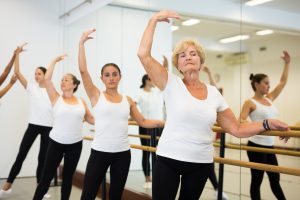What is Barre? The Top 10 Benefits of Barre Workouts
 Whether you’re recovering from an injury or just looking to get stronger, barre is an excellent exercise to try. Inspired by a combination of yoga, Pilates, and ballet, barre is a low-impact, high-intensity total body workout. Barre exercises use body weight or light resistance with high repetitions. The goal is to target each muscle group to failure. Barre can be modified to be accessible for everyone, including healthy individuals, those recovering from injuries, and all age groups. Plus, a dance background isn’t necessary to enjoy the benefits.
Whether you’re recovering from an injury or just looking to get stronger, barre is an excellent exercise to try. Inspired by a combination of yoga, Pilates, and ballet, barre is a low-impact, high-intensity total body workout. Barre exercises use body weight or light resistance with high repetitions. The goal is to target each muscle group to failure. Barre can be modified to be accessible for everyone, including healthy individuals, those recovering from injuries, and all age groups. Plus, a dance background isn’t necessary to enjoy the benefits.
At Orthopaedic Hospital of Wisconsin, we understand the vital role of exercise in a healthy lifestyle. If you need a low-impact exercise recommended by your physical therapist or want to try a new form of exercise, barre can offer many health benefits. In the blog post below, Mariah Cloutier, PT, DPT, describes the top 10 benefits barre workouts can bring into your life.
1. Improves Posture
If you experience poor posture, it may be due to a weakened upper back and shoulder. Barre exercises incorporate upper back strengthening and shoulder stabilizing exercises. And throughout the class, you have the support of the barre. These exercises allow you to maintain proper posture and move deeper into the exercises without sacrificing form.

2. Strengthens Core and Pelvic Floor
Barre classes strongly focus on core engagement and proper lumbar spine alignment. These exercises require abdominal and pelvic floor muscles. Engaging the core throughout class can build strength and endurance in the abdominals and pelvic floor muscles. Building these muscles will better support your body throughout your day.
3. Decreases Risk of Injury
Barre classes target slow twitch muscle fibers (our fatigue resistance muscle fibers) with small movements held for prolonged periods. Training our slow-twitch fibers leads to improved muscle endurance and a decreased risk of injury. Improved muscle endurance can be particularly helpful for runners or other cardiovascular athletes.
4. Improves Bone Density
As we age, our bone density can decrease, especially among women. It is important to continue strengthening the muscles, which, in turn, strengthens our bones, to reduce the risk of developing conditions like osteoporosis. Barre classes incorporate weight-bearing and resistance training exercises with weights and bands, placing stress on the bones. Safely doing this increases bone mass over time and improves body density.
5. Improves Balance
Balance training is important to reduce fall risk and improve safety with functional mobility. Barre classes often work on each side of the body, requiring balance through the standing leg. By working each leg separately, it automatically engages the core muscles. A stronger core improves balance as well.
6. Easy on Joints
Traditional barre classes are low-impact, which means no jumping or hopping. Barre exercises typically use body weight and light resistance at high repetition to work the muscles to failure. Light resistance allows for building strength gains without taxing joints and tendons.
7. Mind-Body Connection
Barre classes often incorporate exercises and movements quite different from what you see in a traditional strength training class. These movements require focus and attention to detail to complete with proper technique. This cognitive awareness in exercise allows for better body awareness and alignment outside of the studio. The more aware we are of our bodies in space, the more in tune we are about feeling pain or discomfort. By being more aware, we can adjust our lives accordingly and drastically reduce the risk of injury in daily life.
8. Total Body Strength Workout
Barre classes target every major muscle group. You will always leave class feeling like you had a well-rounded workout. Building and maintaining muscle strength throughout the body is vital as we age to keep up with the world around us, reduce fall risk, and improve overall participation in life activities.
9. Educated Instructors
All barre instructors are educated in anatomy and physiology and have participated in a certification process before teaching their first class. Throughout the class, the instructor will adjust and provide modifications to ensure everyone is getting the proper workout and to prevent any injuries.
10. Community
Finally, one of the largest benefits of barre is that you won’t be doing it alone. In a barre class, you will have a room full of people to motivate and encourage you throughout the class. Barre classes create an opportunity to connect with others that can help motivate you on your fitness journey.
While barre is an excellent example of a low-impact exercise, a painful orthopedic injury or condition can hold you back from trying it. If you are experiencing pain preventing you from living a healthy lifestyle, the OHOW team is here to help. Make an appointment with one of our talented orthopedic specialists today.

